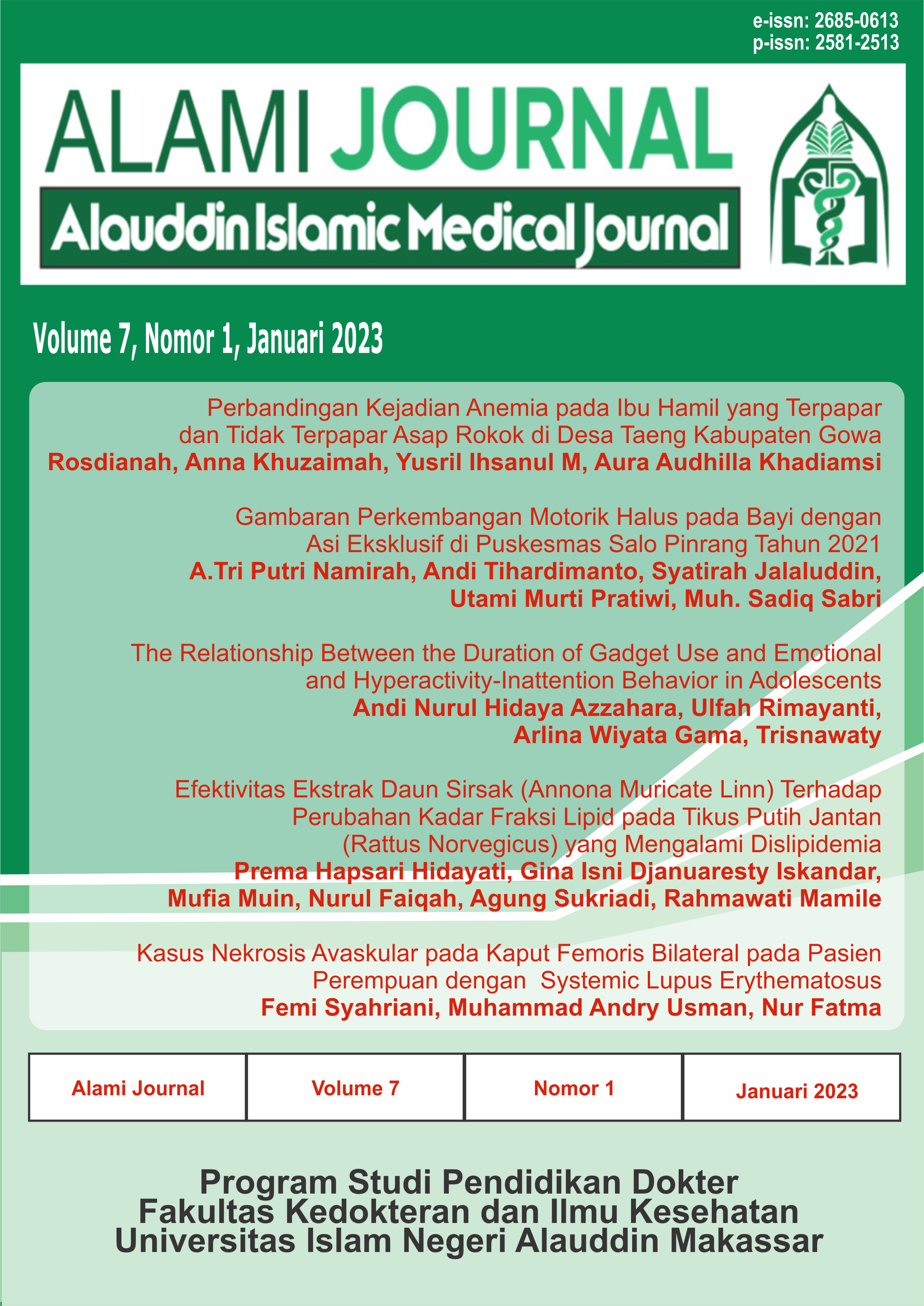Hubungan Durasi Penggunaan Gadget Dengan Perilaku Emosional dan Hiperaktif-Inatensi Pada Remaja
Abstrak
Latar belakang Remaja merupakan masa perkembangan fisik dan mental yang dipengaruhi berbagai faktor. Tujuan Mengetahui hubungan antara durasi penggunaan gadget dengan perilaku emosional dan hiperaktif-inatensi pada siswa di SMA Negeri 4 Kabupaten Wajo. Metodologi Penelitian ini merupakan studi cross sectional dengan pendekatan kuantitatif yang menggunakan Strengths & Difficulties Questionnaire (SDQ) sebagai instrumen untuk menentukan perilaku emosional dan hiperaktif-inatensi pada remaja. Penelitian ini merupakan studi korelasional pada 142 siswa SMA Negeri 4 Kabupaten Wajo. Hasil penelitian dianalisa menggunakan uji Chi-Square dengan nilai signifikansi 5%. Hasil hasil dari uji Chi-Square didapatkan p-value untuk aspek gejala emosional sebesar 0.062 dan aspek hiperaktif-inatensi sebesar 0.170. Hal ini bisa dipengaruhi faktor lain seperti kontrol diri dari remaja itu sendiri. Faktor lain yang mempengaruhi yaitu pola asuh orang tua, tempat tinggal, lingkungan sosial, kesehatan mental, dan spiritual. Kesimpulan Dari penelitian ini dapat disimpulkan bahwa terdapat perbedaan antara kelompok dengan durasi berbeda dalam penggunaan gadget dengan perilaku emosional begitu juga dengan hiperaktif-inatensi pada remaja, tapi tidak signifikan secara statistik.
Referensi
Caskey M, Anfara ViA. Young Adolescents ’ Developmental Characteristics. Res Gate [Internet]. 2020;(October 2020). Available from: http://www.amle.org/Research/ResearchSummaries/DevelopmentalCharacteristics/tabid/1414/Default.aspx
Patton GC, Olsson CA, Skirbekk V, Saffery R, Wlodek ME, Azzopardi PS, et al. Adolescence and the next generation. Nature [Internet]. 2018;554(7693):458–66. Available from: http://dx.doi.org/10.1038/nature25759 doi: 10.1038/nature25759
Ministry of Communication and Information (Indonesian Government). Survey Penggunaan TIK. Jakarta: Kementerian Komunikasi dan Informatika; 2021.
Australian Government (Department of Health). Australian 24-Hour Movement Guidelines for Children and Young People (5 to 17 years). 2019;24.
Rukmana NIN, Ainy Fardana N, Dewanti L, Mujtaba F. Does the Intensity of Gadget Use Impact Social and Emotional Development of Children aged 48-72 Months? Al-Athfal J Pendidik Anak. 2021;7(2):135–44. https://doi.org/10.14421/al-athfal.2021.72-04
Sapardi VS. Hubungan penggunaan gadget dengan perkembangan anak usia prasekolah di PAUD/TK Islam Budi Mulia. MENARA Ilmu [Internet]. 2018;7(80):137–45. Available from: https://www.jurnal.umsb.ac.id/index.php/menarailmu/article/view/634
Alvina, Pratiwi. Gadget Playing Intensity and Suspected (ADHD) in Children. J Biomedika dan Kesehat. 2022;5(2):61–8. https://doi.org/10.18051/JBiomedKes.2022.v5.
Wahyuni AS, Siahaan FB, Arfa M, Alona I, Nerdy N. The relationship between the duration of playing gadget and mental emotional state of elementary school students. Open Access Maced J Med Sci. 2019;7(1):148–51. https://doi.org/10.3889/oamjms.2019.037
IDAI. Rekomendasi IDAI Selama Anak Menjalani Sekolah Dari Rumah. In: Committed in Improving the Health of Indonesian Children. 2020. p. 88.
Heryana A. Jumlah kelompok Fungsi Syarat data. Univ Esa Unggul. 2020;(May):1–20. https://doi.org/10.13140/RG.2.2.23266.15047
Mustamu AC, Hasim NH, Khasanah F. Factor Influence Mental in Adolescences. Int J Environ Sustain Soc Sci. 2020;36–40. https://doi.org/https://doi.org/10.38142/ijesss.v1i1.40
Amaltinga APM, Mbinta JF. Factors associated with depression among young people globally: a narrative review. Int J Community Med Public Heal. 2020;7(9):3711. https://doi.org/10.18203/2394-6040.ijcmph20203949
Pandia V, Noviandhari A, Amelia I, Hidayat GH, Fadlyana E, Dhamayanti M. Association of Mental Health Problems and Socio-Demographic Factors Among Adolescents in Indonesia. Glob Pediatr Heal. 2021;8(28). https://doi.org/10.1177/2333794X211042223
Surat S, Govindaraj YD, Ramli S, Yusop YM. An Educational Study on Gadget Addiction and Mental Health among Gen Z. Creat Educ. 2021;12(07):1469–84. https://doi.org/10.4236/ce.2021.127112
Vanitha SS, Javalkar SR. A study on prevalence and factors associated with depression among medical adolescent students. Natl J Community Med [Internet]. 2018;9(3):172–85. Available from: http://www.njcmindia.org/home/abstrct/1167/March
Preety R, Gayatri D, Priya J. Sleep Deprivation and Cell Phone Usage Among Teenagers. Drug Invent Today. 2018;10:2073–5.
Sarla GS. Excessive use of electronic gadgets: health effects. Egypt J Intern Med 2020 314 [Internet]. 2020;31(4):408–11. Available from: https://ejim.springeropen.com/articles/10.4103/ejim.ejim_56_19 doi: 10.4103/ejim.ejim
Rashid SMM, Mawah J, Banik E, Akter Y, Deen JI, Jahan A, et al. Prevalence and impact of the use of electronic gadgets on the health of children in secondary schools in Bangladesh: A cross-sectional study. Heal Sci Reports. 2021;4(4):1–9. https://doi.org/10.1002/hsr2.388
Setianingsih S. Dampak Penggunaan Gadget Pada Anak Usia Prasekolah Dapat Meningkatan Resiko Gangguan Pemusatan Perhatian Dan Hiperaktivitas. Gaster. 2018;16(2):191. https://doi.org/10.30787/gaster.v16i2.297
##submission.copyrightStatement##
##submission.license.cc.by-nc-sa4.footer##Once an article was published in the journal, the author(s) are: granted to the journal right licensed under Creative Commons License Attribution that allows others to share the work with an acknowledgement of the work's authorship. permitted to publish their work online in third parties as it can lead wider dissemination of the work. continue to be the copyright owner and allow the journal to publish the article with the CC BY-NC-SA license receiving a DOI (Digital Object Identifier) of the work.

